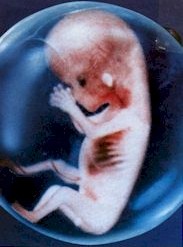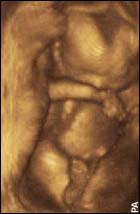When pro-choice people talk about abortion, they sometimes argue about whether life begins at conception. Pro-lifers believe that as soon as the sperm and egg unite, there is the beginning of a new human life. Science teaches that this is true, but many pro-choice people believe that while conception may be the beginning of a life, the zygote (which is the term for a newly fertilized egg) is not a fully independent life and should not be valued.
What people don’t realize is that the vast majority abortions take place long after the zygote stage. Abortions do not destroy a fertilized egg. Rather, they destroy a fetus, or, more rarely, an embryo.

Surgical abortions seldom take place before the sixth to seventh week of pregnancy. At this time, the developing embryo already has a heartbeat and brain waves. The majority of abortions take place in the eighth to tenth week. At this stage, the unborn baby is called a fetus. At this time, the unborn baby already has fingers and toes, a face, and all of her organs. The organs may be primitive – but they are all there. The fetus, at this stage, is obviously human – you can tell by looking at it that it is not a dog fetus or a cat fetus, but a human fetus. It is a human unborn baby in an early stage of development.

Pictures of unborn and aborted babies abound on the Internet. It used to be the case that few people knew what abortion looks like. Now, a simple Google search for “aborted babies” turns up many sites.
But are these pictures real? Or are they done by Photoshop, or other deceptive means? In order to answer this question, one could look at the book “Abortion at Work: Ideology and Practice in a Feminist Clinic” by Wendy Simonds. Wendy Simonds is a pro-choice author whose book is about an abortion clinic. She wrote it after spending time observing the daily workings of the clinic. She interviewed clinic workers. Her book is unabashedly pro-choice. It contains a chapter on how to repel “anti-choice” (pro-life) protesters. Repeatedly, throughout the book, she argues about how necessary abortion is. However, in one chapter, she discusses the difficulty that abortion clinic workers have in dealing with the bodies of aborted babies.

On page 88, she quotes one worker, identified simply as Nell, saying the following, in response to her question about why the aborted remains are hard to deal with:
“Because it looks like a baby. That’s what it looks like to me. You’ve never seen anything else that looks like that. The only other thing you’ve ever seen is a baby…You can see a face and hands and ears and eyes and, you know…feet and toes…It bothered me really bad the first time . . .”
Perhaps if more people could witness abortion procedures or see for themselves what a baby looks like after being torn apart in an abortion, they would agree that abortion is legalized infanticide.
Share on Facebook